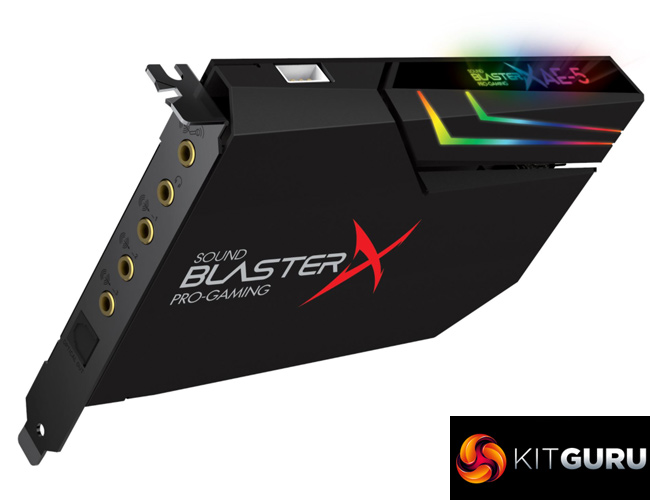It's been a while since I have used a product from Creative, but the Sound BlasterX AE-5 PCIe sound card has certainly impressed me.
It is a diminutive little thing, measuring 145 x 20 x 128 mm, but it sure packs a punch – the AE-5 had no problems powering my Sennheiser HD 650s at ‘normal' gain, something which is quite impressive considering its draws all its power from the PCIe bus.
Creative also bundled some software with the AE-5, and while this isn't something that I am too keen on myself, it does give the end-user some options – the EQ can be tweaked, mic input settings can be adjusted and you can also enable virtual 7.1 surround-sound.
The actual sound quality is where the AE-5 shines, though. It delivers a detailed and very listenable sound – perhaps slightly smoother than I would've liked, but for a gaming-focused sound card that is probably to be expected.
Still, music sounded great through the AE-5, while I also had plenty of fun while gaming. If you are looking for a high-quality PCIe sound card, then, the Creative Sound BlasterX AE-5 comes well recommended.
My only concern is pricing and its overall appeal. At £129.99, Creative is going to have a tough job convincing the average gamer to upgrade – especially since on-board audio has come on leaps and bounds over the last few years. I would imagine many users – folks who use typical gaming headsets – would rather spend that cash elsewhere, perhaps on a new graphics card or SSD.
That being said, the Creative Sound BlasterX AE-5 is definitely a high quality product, so if you are keen to upgrade your listening experience, the AE-5 will serve you well.
You can buy one from Creative for £129.99 HERE.
Discuss on our Facebook page, over HERE.
Pros
- High quality sound.
- Capable of driving Sennheiser HD 650s.
- Software lets you tweak the audio to your liking.
- Attractive piece of kit.
Cons
- On-board audio has come a long way, so many users may not need to upgrade.
KitGuru says: If you are in the market for a high quality sound card, the AE-5 is a great buy. Gamers who only use a standard headset may not benefit hugely, however.
 KitGuru KitGuru.net – Tech News | Hardware News | Hardware Reviews | IOS | Mobile | Gaming | Graphics Cards
KitGuru KitGuru.net – Tech News | Hardware News | Hardware Reviews | IOS | Mobile | Gaming | Graphics Cards





Ah creative… great cards, crap drivers. Many believe that the onboard sound cards killed the sound card market, but in reality crap or non existent drivers did.
How can you keep on selling a sound card but not supporting the latest windows?
Also some after market support with parts for their speakers could go a long way.
I have Creative Inspire P5800, they still work great (even if in terms of clarity the newer T3300 I got are better) but the volume knob faulted a year after I got them, now you don’t dare touch it, it may silence or skyrocket the volume just by a light touching.
The problem is that it is not replaceable or repairable because it is on a chip that also turn on and off the system, but I could have got a new one if creative was offering one! (I remember that back in the day their main rival logitech had this option for they high end speakers).
Yes, stay far away from Creative and Behringer audio equipment. Both of them abandon their drivers as soon as a product is released, never again updating them for future version of Windows or MacOS.
Behringer staff even used “it worked with the latest version of Windows when the driver was released” as a defence in their support forums. Behringer STILL sell products that are not fully compatible with Windows 10 even though the product pages STILL say that it works with “Windows 7 or newer” (because Windows 10 was not released when the text was written).
Thats a funny statement, considering that the X-Fi Xtremegamer I have laying around has windows 10 drivers according to the website. The thing holding it from being installed is that it uses PCI which no newer motherboards tend to carry
Such a dated fallacy. The drivers are fine with W10, they do everything as advertised and the audio performance is second to none. Scout mode gimmicky, voice modulation also gimmicky. Otherwise class leading PC audio, WSAPI or ASIO. As stable as it gets.
Well I never mentioned recent products, I just pointed at what made people abandon sound blasters. We have a saying in my country, “It is better to lose an eye than get a bad reputation” not sure how to translate it accurate in english, but you get the point.
After all I do still buy on their products, last year I got T3300 speakers and I’m greatly satisfied by them.
Price + bad driver support is what did it for me with creative and asus. Onboard audio sounds very good anyway and saves money. Realtek does an amazing job of driver releases and are very good. Having to restart twice is a bit of an issue, that goes down to windows though. Now if only windows could make a kernel that did not need a full restart and just the kernel restarted itself.
i remember about auzentech cards…. a LOT of time ago
It wasn’t drivers, it was windows 7, and the death of EAX that killed the soundcard.
What do you mean? Is there something specific that windows 7 did that made the sound blaster drivers for windows 7 not working?
My mistake, it was actually Vista, but as that never became universally adopted Windows 7 put the sound card to bed. With Vista/7 the hardware layer of processing was removed and dumped onto the cpu. With that EAX died overnight, and the fantastic audio that used to be amazing lost a lot of depth and ear candy became a thing of the past. I don’t think games made even today have gotten to the point of where it once was. Essentially Microsoft chose to remove hardware accelerated audio, and with that 3d audio that had a very dynamic sound stage became flat. Creative made a work around called ALchemy, I believe even Realtek made something too. Basically consumers stopped hearing a difference between their expensive sound cards and the onboard solutions. It used to be absolutely a night and day difference, you didn’t need to be an audiophile to hear anything different, it was just something that was instantly apparent. We are often lead to believe that is because onboard audio has improved (which it has), but the magic jelly bean you would have heard before stopped existing, and so the consumers stopped buying.
Interesting, I wasn’t aware of that, I stepped off in the XP era from discreet sound cards. After a fast google search I see windows 10 do have sound hardware acceleration, did they added this back or it is something else?
I mean if I’m to hear something better I could consider getting again a discreet sound card for my gaming system.
I am in IT for a very long time. I used to install SoundBlaster 16 cards in DOS, followed Creative through excellent products like the AWE32 , the Live Series , Audigy, etc. It is driver support that killed them. I have a ton of useless soundblaster cards sitting in boxes or shelves, due to inability to install in later OSes. There were some open source projects that I could use, but users could not. Creative at some point asked for money for new drivers, the Audigy series if I remember correctly. Well screw that, I advised all my customers against Creative products, and I steer all my low and medium end audiophile customers towards Asus Xonar products. Some bugs here and there, but nothing serious.
I am in IT for a very long time. I used to install SoundBlaster 16 cards in DOS, followed Creative through excellent products like the AWE32 , the Live Series , Audigy, etc. It is driver support that killed them. I have a ton of useless soundblaster cards sitting in boxes or shelves, due to inability to install in later OSes. There were some open source projects that I could use, but users could not. Creative at some point asked for money for new drivers, the Audigy series if I remember correctly. Well screw that, I advised all my customers against Creative products, and I steer all my low and medium end audiophile customers towards Asus Xonar products. Some bugs here and there, but nothing serious.
What a review! Complete silence on s/n ration, dynamic range, THD, output levels and amplifications level for headphones…and so on. True audiophile type review, a lot of words with zero numbers to prove performance. Smells like a payed content. What a shame!
“powering my Sennheiser HD 650s at ‘normal’ gain, something which is quite impressive considering its draws all its power from the PCIe bus.” PCI-e bus can supply up to 75W of power. A giant FACEPALM follows…
No, the 1x slot is not 75 watts.
https://en.wikipedia.org/wiki/PCI_Express#Power
https://www.asus.com/support/FAQ/104406/
OK, i`ts my bad, not 75W, its 25W for rev.2.0 – it does not make a difference. External power in sound cards being used for less noise in power paths. The issue not its quantity, but quality. Even 3W at some 2 to 3 volts is sufficient enough to blow out your eardrums even with planars….
KitGuru, Be so kind, and unique from others reviewers, do the proper outpt testing. OBJECTIVE measurment and analisys is what serious readers expect from you, BY DEFAULT.
It’s the driver not Windows asking for the restarts, NVidia drivers just restart the kernel when updating with no issues (has been that way since Win 7), not sure why more drivers don’t take this approach.